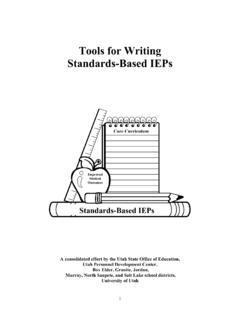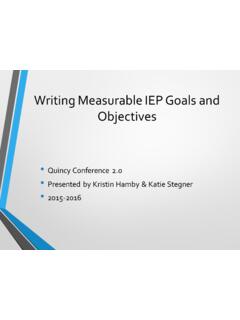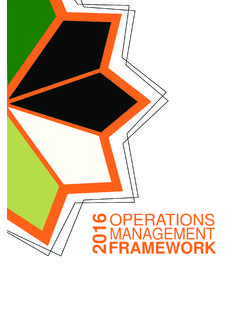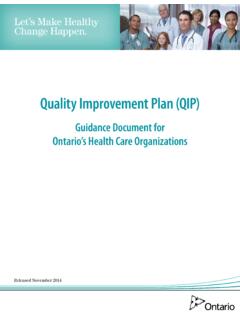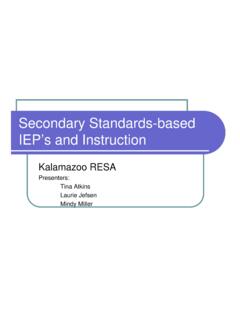Transcription of 1 4/16/08, ESU2 lp
1 1 4/16/08, esu2 lp The Present Level of Educational Performance (PLEP) is a summary describing the student's current achievement in the areas of need as determined by an evaluation. It specifically addresses the student's strengths, effective teaching approaches, and interventions to enable student success.
2 It explains the needs of the student and states how the student's disability affects his or her involvement and progress in the general curriculum. The PLEP contains current specific, measurable, objective baseline information for each area of need affected by the disability. In addition, it links the evaluation results, the expectations of the general curriculum, and the goals for the student. For preschool children, the PLEP describes how the disability affects the child's participation in age appropriate activities. The PLEP also addresses the student's transition needs in the areas of instruction, employment and post-school adult living, community services, and related services.
3 Every goal must relate to a need identified in the PLEP. The PLEP: Summarizes the individual's current performance Incorporates information from a variety of sources in an integrated statement. Facilitates instructional planning by providing a bridge from the evaluation process and results to instructional interventions. Provides guidance for future interventions by communicating the results of past interventions. Describes behaviors specifically in objective, measurable terms. Describes other educational needs that result from the student's disability.
4 Describes the student's performance in areas of need in relationship to the standards and benchmarks of the district's general curriculum. Describes student strengths that are relevant to reaching the IEP's annual goals and the long-term expectations for the student. Describes factors, which have led to past success for the student (effective interventions and strategies). Describes the student's performance levels using the same indicators specified in the goals of the past IEP (for IEP reviews). Describes the student's current needs relative to long- range goals.
5 Provides current baseline information for areas in which goals are set, and special education is provided. Examples: 1. In the general education curriculum, students are expected to complete all assignments. John turns in an average of 60% of his math assignments, 50% of his reading and language assignments (on average per week). Of assignments turned in, fewer than 75% are complete. Accuracy of turned-in work fluctuates markedly from less than 10% to 100%. 2. Christine is working on the district's standard to be able to read, understand, and respond to a variety of materials for various purposes.
6 Our focus will be on functional vocabulary. Christine is able to say the sounds of 15 of 26 letters of the alphabet independently (missed v, d, l, r). With a gestural prompt she was able to say the sounds of w, x, y, z, g, l, n. Chris is able to read 19 survival words. She is also working on the standard of writing effectively for a variety of purposes. Christine can write her name without a model 70% of the time. She forgets the "r" or transposes the "r" and the "I". Her "z" looks like a "2" and her "n" and "h" look alike. Christine cannot say her address.
7 3. Charlie is having difficulties in math. He is unable to meet the general education standards in the area of understanding and applying a variety of problem-solving strategies. He can compute additional problems when using touch math. He has difficulty processing story problems 2 4/16/08, esu2 lp when they are read to him in a one-to-one situation.
8 He does not understand the relationship of the language in the problems and the computation. He needs to learn to set up and solve story problems. He was not able to complete any of the addition or subtraction story problems on the second grade math assessment. There is a direct relationship between the goal and the needs identified in the PLEP. Goals are also descriptions of what a student can reasonably be expected to accomplish within a 12 month period with the provision of special education services. There are four critical characteristics of a well written goal: it is meaningful, measurable, able to be monitored, and useful in making decisions.
9 When a goal is written it must be stated so it is meaningful. The "meaningful determination" is made by considering a number of factors: The skill the goal represents is necessary for success in current and future environments; The family believes the accomplishment of the goal is important; The goal specifies a level of performance and an expectation that is reasonable; and Its accomplishment is related and significant to the behavior. Goals are measurable. They must reflect behavior that can be measured. A goal can be monitored.
10 There are multiple increments in performance between the present level of performance and the criteria stated in the goal. The goal should be written so it can be monitored frequently and repeatedly. Finally, goals are useful in making decisions regarding a student's education. Monitoring the goal results in data used to determine the effectiveness of the individual's education program. Appropriate changes may be made to the student's IEP in order to help him or her achieve optimum success. Goals must be written so they can pass the "Stranger Test." In other words, a goal is written so someone who did not write it could use it to develop appropriate instructional plans and assess student progress.
